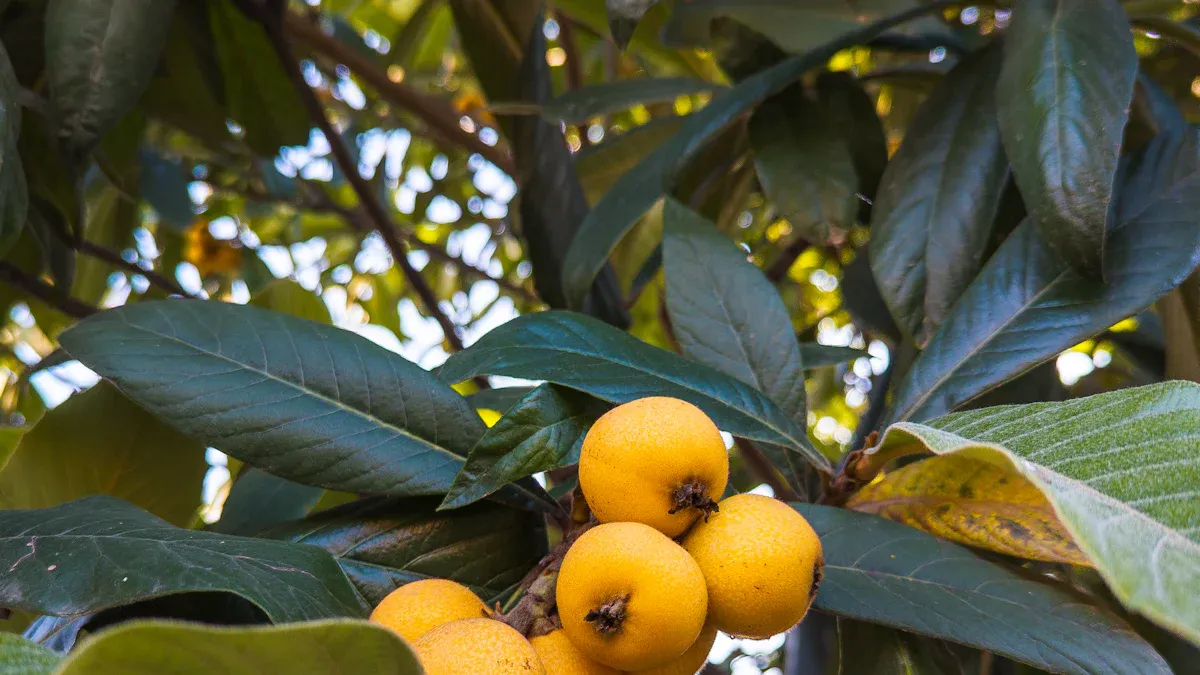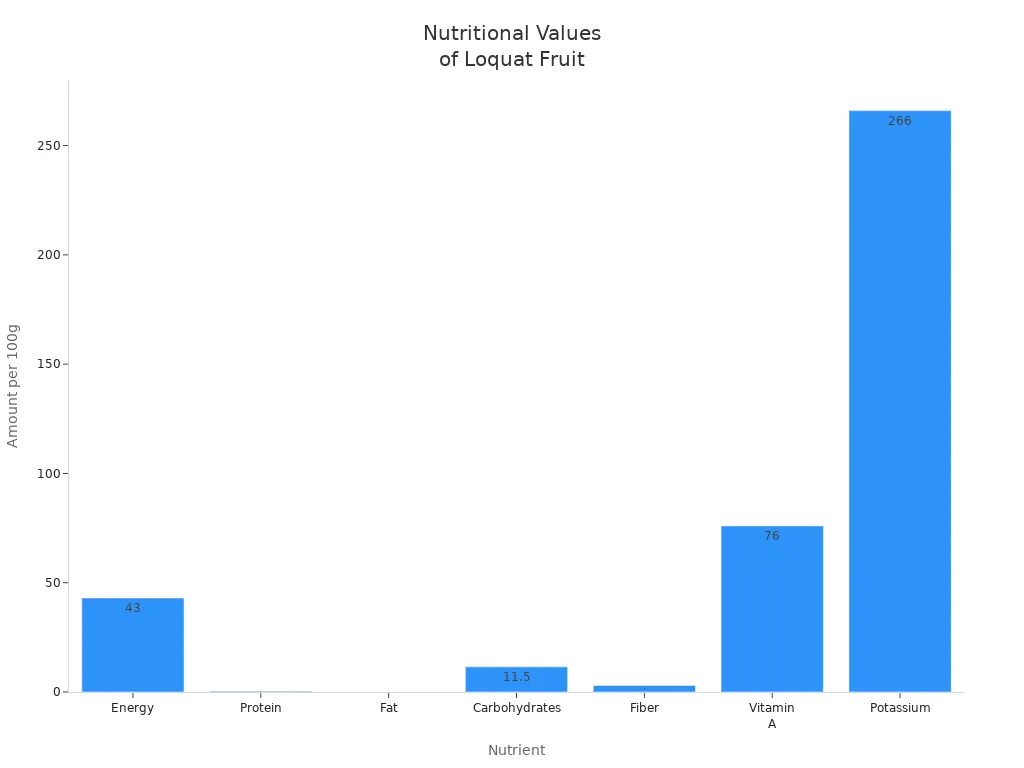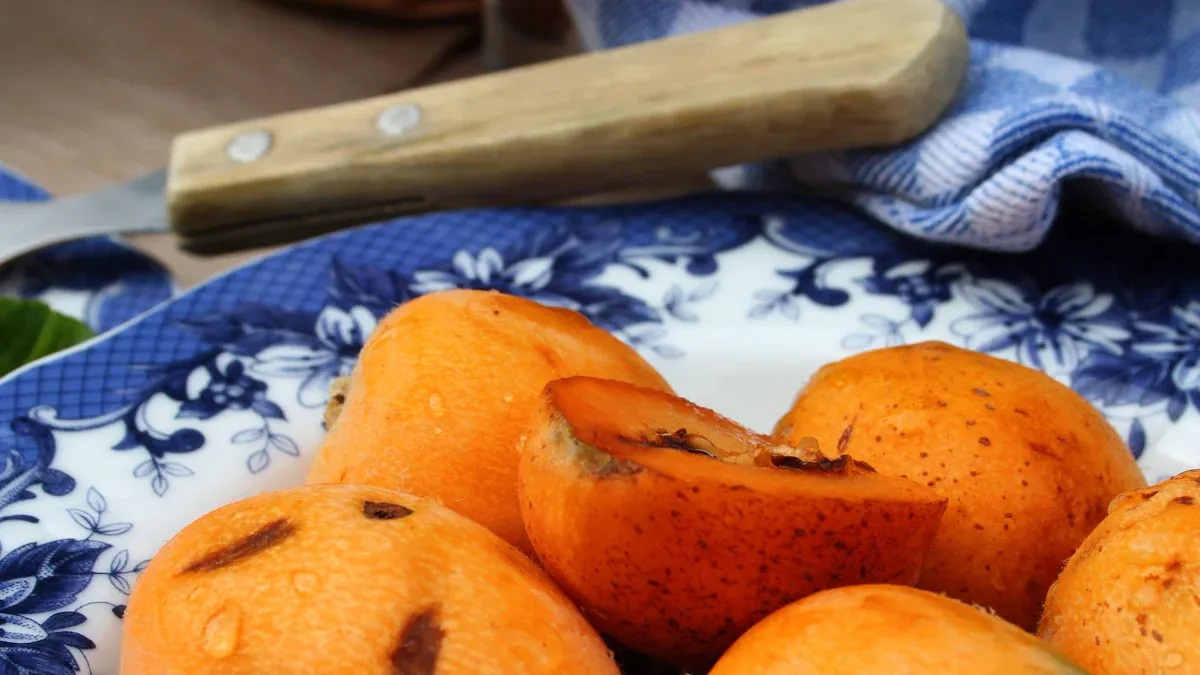T: +86-731-89865681
E: info@kingherbs.com
E: info@kingherbs.com
27Fl, Blding A, Cimen Fun City, Wanjiali Road, Changsha 410014, Hunan, China
Views: 0 Author: Site Editor Publish Time: 2025-09-09 Origin: Site
You discover loquat, a fruit with a captivating balance of sweetness, floral aroma, and gentle tartness. Its golden flesh delights your palate, while its connection to loquat leaf extract opens new pathways in wellness.
In recent years, demand for loquat leaf extract has surged in the U.S. and Europe, fueled by an interest in natural, plant-based solutions and advancements in extraction technology.
The market has nearly doubled, reflecting a shift toward healthier lifestyles and innovative applications in supplements.

You may know the loquat as a small, golden fruit with a rich history. Botanically, it belongs to the species Eriobotrya japonica. This tree thrives in subtropical climates and has roots in Asia, especially China. Over time, the loquat fruit spread to gardens and orchards worldwide. Today, you can find it in many regions, from the United States to the Mediterranean.
Here is a quick overview of its origins:
| Source | Botanical Origin | Native Region |
|---|---|---|
| Britannica | Eriobotrya japonica | Central eastern China |
| Pacific Horticulture | Eriobotrya japonica | Dadu River Valley, Sichuan Province |
| Fairchild Garden | N/A | Asia, widespread in subtropical areas |
| Selby Gardens | N/A | China |
You will notice that the loquat fruit comes from a single main species, but growers have developed many cultivars. These cultivars flourish in places like Vietnam, Israel, Greece, the USA, and Mexico.
| Species/Cultivar | Region of Cultivation |
|---|---|
| Eriobotrya japonica | Worldwide (commercially used) |
| Various cultivars | Vietnam, Israel, Greece, USA, Mexico |
Tip: If you travel to a new country, look for local varieties of loquat fruit at markets. Each region may offer a unique taste experience.
When you see a loquat, you notice its inviting color and shape. The fruit usually measures between 1 and 3 inches in length. Its skin ranges from light yellow to deep orange, sometimes with a red blush. The shape can be oval, rounded, or even pear-like.
Here is a summary of its physical traits:
| Characteristic | Description |
|---|---|
| Size | 1 to 3 inches long |
| Color | Yellow to orange, sometimes red-blushed |
| Shape | Oval, rounded, or pear-shaped |
You will find the flesh juicy and fragrant. The skin feels thin, and the inside contains several large, glossy seeds. When ripe, the loquat fruit offers a vibrant appearance that stands out in any fruit bowl.
When you bite into fresh loquats, you experience a unique blend of sweet, floral, and tart flavors. The sweetness comes from natural sugars, especially sucrose, which is more pronounced in white-fleshed varieties. Malic acid delivers a gentle tart sensation, balancing the overall taste. Volatile organic compounds add subtle floral notes, making the loquat taste both refreshing and aromatic. Breeders often minimize bitter compounds to enhance consumer enjoyment.
Sugars provide sweetness.
Malic acid creates tartness.
Volatile organic compounds contribute to aroma.
Bitter compounds are reduced for better flavor.
Tip: The balance of sweetness and tartness makes loquats a favorite among fruit enthusiasts.
You notice that fresh loquats have a texture similar to pears and peaches. The flesh feels juicy and slightly firm, offering a pleasant bite. The skin is thin and easy to peel, while the inside remains succulent. This combination of crispness and juiciness sets loquats apart from other stone fruits.
Ripe loquats deliver a sweet and juicy experience. You taste honey-like notes and enjoy the soft, golden flesh. In contrast, underripe loquats can be sour and astringent, with a firmer texture. Most consumers prefer light orange loquats for their balance of firmness and fewer skin defects. The ratio of total soluble solids to titratable acidity (TSS/TA) influences the flavor, with higher ratios indicating sweeter fruit.
Ripe loquats: sweet, juicy
Underripe loquats: tart, astringent
Each loquat variety offers a distinct flavor profile. You can compare popular types using the table below:
| Variety | Fruit Flavor | Size | Ripening Season | Best for Regions | Pros | Cons |
|---|---|---|---|---|---|---|
| Champagne | Sweet-tart | Small | Early spring | Warm climates | Low maintenance | Smaller fruits |
| Gold Nugget | Rich, sweet | Large | Late spring | Coastal regions | High yield | Needs pruning |
| Vista White | Mild, sweet | Medium | Mid-spring | Cooler climates | Ornamental appeal | Moderate yield |
| Big Jim | Very sweet | Large | Late spring | Versatile | Heavy production | Thinner skin |
| Early Red | Tangy, bold | Small | Early spring | Subtropical | Drought-tolerant | Small fruit size |

You usually remove the peel before eating loquats, as it does not enhance the flavor. The seeds contain toxic compounds, so you should avoid consuming them. Some culinary traditions use roasted seeds for flavoring, but the fruit itself remains the highlight for its sweet and tangy taste.
Peel: typically removed, minimal impact on flavor
Seeds: not edible in large amounts, sometimes roasted for flavor
Flesh: sweet, tart, and enjoyable when fresh
You encounter loquat leaf extract as a rising star in the wellness industry. This extract comes from the leaves of the Eriobotrya japonica tree, the same tree that produces the flavorful loquat fruit. You find it in supplements, skincare, and functional foods. Researchers have linked loquat leaf extract to benefits for inflammation, respiratory health, and metabolic support. You see it used for its antioxidant, anti-inflammatory, and antidiabetic properties.
You notice that loquat leaf extract contains a rich blend of bioactive compounds. These compounds include flavonoids, triterpenoids, and phenolics. The table below highlights some of the main bioactive compounds found in loquat leaf extract:
| Compound Identifier | Compound Name |
|---|---|
| 20 | epicatechin |
| 21 | procyanidin B-2 |
| 22 | procyanidin C-1 |
| 23 | procyanidin oligomer |
| 24 | δ-oleanolic acid |
| 25 | 3-O-(E)-p-coumaroyl tormentic acid |
| 26 | roseoside |
| 27 | 2α-hydroxyursolic acid |
| 16 | cinchonain Ib |
| 32 | cinchonain Ia |
| 31 | quercetin-3-O-α-l-rhamnoside |
| 33 | arbutin |
You also benefit from the nutritional values present in loquat fruit and leaves. These include fiber, vitamin A, manganese, and potassium. You can see a comparison of nutritional values in the chart below:

You find several companies in the loquat leaf extract market. These include Xi'an Greena Biotech, Qingdao Dacon Trading, MARUZEN PHARMACEUTICALS, Green Heaven India, TAJ AGRO INTERNATIONAL, Alfa Chemistry, Creative Enzymes, and Herblink Biotech. Most competitors focus on purity, certifications, and applications in supplements. You notice that liquid loquat leaf extract typically costs around $19.95.
You search for loquat leaf extract and related terms. Popular keywords include active compounds, lipid metabolism, PCSK-9, CYP7A1, and p-AMPK. You also see searches for respiratory, metabolic, and inflammatory benefits. Scientific studies support antioxidant, anti-inflammatory, antidiabetic, and anticancer activities.
| Keywords |
|---|
| Loquat leaf extract |
| Active compounds |
| Lipid metabolism |
| PCSK-9 |
| CYP7A1 |
| p-AMPK |
You may start with curiosity about loquat fruit flavor. You soon discover that loquat leaf extract offers a concentrated source of health benefits. You can use it to support inflammation, blood sugar balance, and skin health. You bridge your interest in taste to a broader wellness routine.
Craving the sweet-tart essence of loquats? Explore their flavor story and discover why loquat leaf extract is trending in supplements, skincare, and functional foods. From ancient traditions to modern science, you unlock nature’s balance for your daily routine.

You discover a world of culinary possibilities when you explore loquat in your kitchen. This fruit’s vibrant flavor and juicy texture make it a versatile ingredient across cultures. You can enjoy loquats fresh, add them to breakfast bowls, or transform them into preserves and desserts.
| Culture | Culinary Uses |
|---|---|
| General | Breakfast bowls, glazed toppings, fruit salads, smoothies, jams, chutneys |
| China | Fresh, stewed, dried; jams, jellies, desserts |
| Japan | Teas, liqueurs, delicate flavor applications |
| Mediterranean | Salads, salsas, grilled dishes |
You might start your morning by slicing loquats into oatmeal or yogurt, pairing them with berries and nuts for added nutrition. Their sweet-tart profile enhances fruit salads and smoothies, providing a refreshing twist. If you prefer something more indulgent, you can glaze loquats with brown sugar and serve them as a dessert topping.
Tip: You can make homemade jam or chutney with loquats. Simmer the fruit with sugar and spices to create a spread for toast or cheese boards.
In China, you find loquats featured in jams, jellies, and desserts. Stewing or drying the fruit preserves its flavor for year-round enjoyment. In Japan, loquats appear in herbal teas and liqueurs, prized for their subtle aroma. Mediterranean cuisine uses loquats to add sweetness to salads, salsas, and grilled meats.
If you wonder how to eat loquats, you should remove the thin peel and seeds before enjoying the flesh. The fruit tastes best when ripe and slightly soft. You can eat loquats raw, cook them into sauces, or blend them into drinks.
Add loquats to breakfast bowls with nuts and berries.
Glaze with brown sugar for dessert toppings.
Use in fruit salads and smoothies.
Make jams, chutneys, and spreads.
Brew dried leaves for herbal tea.
You expand your culinary repertoire by experimenting with loquats in both sweet and savory dishes. Their adaptability allows you to create recipes that suit your taste and cultural preferences.
When you add loquat to your diet, you introduce a powerhouse of nutrients that support your overall health. This fruit stands out for its low calorie count and high fiber content, which can help you manage your weight by keeping you full longer. You also benefit from a rich supply of vitamins and minerals that play essential roles in your body.
You get a boost of Vitamin A, which helps maintain healthy vision and strengthens your immune system.
B vitamins, including B6 and B12, support energy production and aid in forming red blood cells.
Potassium in loquats helps regulate your blood pressure and supports muscle function.
Manganese contributes to bone health and assists in metabolic processes.
The fiber in loquats promotes digestive health and can help lower cholesterol.
You also gain protection from disease thanks to the fruit’s unique compounds. Loquats contain carotenoids, ascorbic acid, and polyphenols, all of which act as antioxidants. These substances help neutralize free radicals, reducing your risk of chronic diseases.
Regular consumption of loquats may help prevent hyperlipidemia and lower your risk of cardiovascular complications.
The nutritional profile of loquats supports their classification as a functional food, making them a smart choice for disease prevention.
The Navela variety, in particular, offers high nutritional quality. It contains proteins, healthy fats, and essential minerals. Its micronutrient richness makes it valuable for anyone seeking to enhance their diet with functional foods.
Note: By choosing loquats, you support your body’s natural defenses and contribute to long-term wellness.
You cultivate loquat trees in regions with subtropical or warm temperate climates. These trees flourish when you provide temperatures that slow vegetative growth in early fall and maintain cool, frost-free winters. You select sandy loam soil for optimal results, but loquats adapt to clay or gravelly limestone if you ensure proper drainage and avoid flooding.
Tip: Loquat trees prefer deep, well-drained soil. You improve fruit quality by choosing a site with good air circulation and sunlight.
You plant loquat seeds or young saplings in spring. You space each tree to allow for healthy root development and canopy growth. You water regularly, especially during dry spells, but you avoid overwatering to prevent root rot. You apply balanced fertilizer to support flowering and fruit set.
During the growing season, you monitor for leaf tip burn, which often occurs in high temperatures. You inspect leaves for signs of scale insects or fruit flies, as these pests can damage both foliage and fruit. You watch for diseases like fire blight and leaf spot, which threaten tree health and yield.
Harvesting loquats requires careful timing. The fruit ripens all at once, giving you a short window to pick them at peak flavor. You gather ripe loquats by hand, taking care not to bruise the delicate skin. You must act quickly because loquats have a short shelf life and spoil easily if left on the tree.
| Challenge | Impact on Cultivation |
|---|---|
| Simultaneous ripening | Narrow harvest window |
| Short shelf life | Requires prompt picking |
| Leaf tip burn | Reduces leaf vitality |
| Insect infestations | Damages fruit and foliage |
| Disease susceptibility | Limits growth and productivity |
You succeed in loquat cultivation by managing climate, soil, and pests. You harvest at the right moment to enjoy the freshest fruit and maintain tree health for future seasons.
You experience loquat as a fruit with a sweet-tart flavor and juicy texture, perfect for breakfast or smoothies. Loquat leaf extract supports your wellness routine, offering benefits for skin, digestion, and respiratory health.
Loquat’s natural sweetness and antioxidant power make it a smart choice for both taste and health.
| Dual Appeal | Description |
|---|---|
| Delicious Fruit | Enjoy fresh, in salads, or as a dip. |
| Wellness-Focused Leaf Extract | Brew as tea or take as a supplement for added health support. |
Try loquats in your meals and explore loquat leaf extract for daily vitality.
You taste a blend of sweet, floral, and tart notes. The flavor reminds you of apricots, peaches, and cherries. Ripe loquats offer honey-like sweetness, while underripe ones taste more acidic.
Tip: Eat loquats when they feel soft and golden for the best flavor.
You should avoid eating loquat seeds. They contain toxic compounds. The peel tastes bitter, so most people remove it before eating. Enjoy only the juicy flesh.
| Part | Edible? |
|---|---|
| Flesh | Yes |
| Peel | Usually no |
| Seeds | No |
You can add loquat leaf extract to teas, supplements, or skincare products. Many people use it for its antioxidant and anti-inflammatory benefits.
Brew as herbal tea
Take as a dietary supplement
Apply in skincare routines
You find fresh loquats at farmers’ markets, specialty grocery stores, or international markets. Availability depends on the season and your location.
Note: Loquats ripen in spring, so shop early for the freshest fruit.
You gain vitamin A, fiber, and antioxidants from loquat fruit. These nutrients support your immune system, digestion, and skin health.
| Nutrient | Benefit |
|---|---|
| Vitamin A | Vision, immunity |
| Fiber | Digestion |
| Antioxidants | Cell protection |